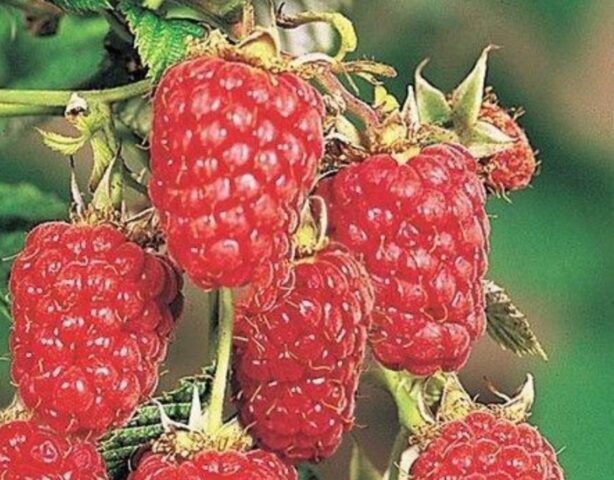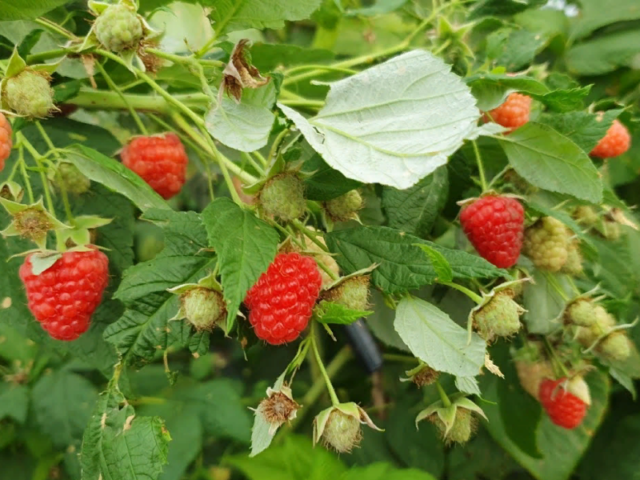Content
Enrosadira raspberry is a relatively new hybrid that has already won the love of gardeners. Excellent taste and good characteristics make the crop suitable for individual and industrial cultivation.

During the harvest period, Enrosadir raspberry bushes are strewn with ripe berries
Breeding history
The Enrosadir hybrid was bred by the Italian scientist Aldo Telch. This happened in 2004 as a result of crossing two varieties: T44L04 Lagorai and T35L04.
The work was carried out for several years in a nursery called Vivai Molari, whose director at that time was G. Molari.
The repairable hybrid Enrosadir was highly praised by experts at the international exhibition MACFRUT, and in 2013 its creators applied for registration and a patent.
Description of Enrosadira raspberry variety
Externally, Enrosadira remontant raspberry looks like a tall annual or biennial plant with powerful branches and large berries. Otherwise, the culture is not much different from other representatives of the species.
Berries
The elongated conical fruits of this raspberry are quite large - about 3 cm in length and 2 cm in width. The weight of one berry varies between 6-12 g.
At the stage of full maturity, the fruits are glossy, bright red, slightly pubescent. One-dimensional, tightly adjacent drupes contain a small number of seeds.
The flesh, which has a pleasant sweet taste, is dense, juicy, and meaty. During the ripening period, the berries exude a rich raspberry aroma.
The fruits are covered with a thin, but quite strong and resistant to mechanical damage skin. This ensures good transportability of fresh berries and makes this hybrid suitable for industrial cultivation.

Enrosadir raspberries do not deform when picked from the bush
Bush
Enrosadir raspberry bushes are powerful and vigorous. On average, the height of strong, upright shoots at the end of summer is 170 cm. Under favorable conditions, especially when cultivated in protected soil, raspberry stems can grow up to 2.5 m.
Flexible young shoots painted light green in the second year of life become lignified and acquire a light brown or grayish-orange hue. The surface of the stem is covered with straight, short, red-brown spines with a thick base.
During the growing season, at the very base of the bush, and sometimes from buds located below the soil level, laterals grow - strong branching shoots capable of bearing from 20 to 30 berries. Moreover, the lower the lateral is located, the longer it is and the more fruit it can bear.
The dark green raspberry leaves have a round-oval shape with a wide base and a pointed tip. The surface of the sheet plate is glossy, corrugated, the edge is jagged.
The flowers are white, small, about 1 cm in diameter.
A powerful, well-branched root system goes deep into the soil, which allows the plant to obtain moisture even in dry summers.
The hybrid is adapted for cultivation in almost all regions of the country, except the coldest. Enrosadir raspberries are cultivated in the southern, central regions and Siberia.

Intense foliage of raspberry stems
Characteristics of Enrosadir raspberries
The Enrosadir hybrid is a mid-late remontant raspberry that ripens on the shoots of the current and last seasons. It begins to bear fruit already in the first year of its life, although there are not very many berries at this time. The fact is that raspberries produce most of the harvest on last year's shoots (approximately 70%).
Ripening time and yield of Enrosadir raspberries
On the previous year's stems, ripe berries appear in late July, early August.
On new, that is, shoots formed this year, ripe berries will appear by the end of summer or early autumn. As a rule, the second harvest period is usually longer than the first and can last until the cold weather.
The hybrid is characterized as high-yielding - under favorable growing conditions, about 1.5 kg of fresh berries can be collected from a bush, and in the case of industrial cultivation - 25 tons per 1 hectare.
The berries of the Endosadir hybrid are eaten fresh and also used for preparing and decorating desserts, baked goods and soft drinks. These raspberries are suitable for drying and freezing.

Enrosadir raspberries produce two harvests per year
Frost resistance
The frost resistance of Enrosadir raspberries is characterized as good. Mature plants can withstand temperatures down to -26 °C. This makes the hybrid especially popular among Siberian gardeners.
Disease resistance
The Enrosadir hybrid has good resistance to diseases such as dead shoots, rust and late blight root rot. Less often than others he suffers from purple spotting.
Advantages and disadvantages
Enrosadir raspberries have almost no flaws. But she has a lot of advantages.

One of the advantages of the Enrosadir raspberry is its large fruit.
Pros:
- good presentation of the fruit;
- long fruiting;
- good yield;
- high level of first-grade fruit content (about 90%);
- versatility of use;
- drought resistance and the ability to withstand temperature drops down to -26 ° C;
- immunity to infections and harmful insects;
- ability to withstand transportation over long distances;
- almost one hundred percent survival rate and good growth of seedlings;
- high reproduction rate;
- Possibility of growing in open ground and greenhouse.
Minuses:
- slight change in the color of the berries during storage;
- with early cooling, it is not possible to harvest part of the crop;
- the need for winter shelter in cool regions.
Features of growing Enrosadir raspberries
Enrosadira raspberries love the sun, so it is better to choose a site for growing it that is sunny and protected from drafts. Plants can be planted twice a year - in spring (mid-late April) and autumn (late September, October).

Enrosadir raspberries will like the southern side of the plot more
Landing rules
Young shoots are planted in deep trenches (about 40 cm) at a distance of 30-40 cm from each other. The distance between rows must be at least 1.5 m.
The seedlings are placed in the planting hole so that the root collar is located at soil level - neither higher nor lower, covered with soil and watered abundantly.

Wide row spacing will help avoid crowding of Enrosadira raspberry plantings
How to care
In order for raspberries to grow and develop normally, you need to provide them with proper care, which includes:
- Watering. Despite the fact that Enrosadira is characterized as a drought-resistant plant, it still needs to be irrigated. Otherwise, a lack of moisture will cause the leaves and shoots to dry out, and the fruits to become small and limp. Therefore, if with a normal amount of precipitation you can not water the raspberries, then in the dry season you will have to moisten the soil at least once every seven days to such an extent as to wet it 0.5 m deep.A week before harvesting, stop watering, otherwise the raspberries will be watery.
- Feeding. Enrosadir raspberries are fertilized four times a year: in early spring, during bud break, during budding and in the fall in preparation for winter. The first three times, nitrogen mineral fertilizers are used, and the last time, potassium-phosphorus fertilizers. In addition, it is recommended to add organic matter to the soil three times a year.
- Trimming. The processing technique for Enrosadir raspberries depends on its type. Annual plants are cut at the root in late autumn, and in the spring new bushes are formed from the remaining stumps. Two-year-old raspberries are pruned in several stages. Around the end of March, beginning of April, sanitary and normal pruning is carried out, during which dry and diseased shoots are removed, and the plantings are also thinned out. The second is carried out at the end of May, shortening the tops of the shoots of the current year's growth, and in July, after fruiting on the branches of last year has ended, they are cut out at the root.
- One of the important activities is raspberry garter. This allows you to prevent mechanical damage to the shoots, facilitate harvesting, and also reduce the likelihood of developing fungal diseases.
- Preparing for winter. Despite the good frost resistance of Enrosadir raspberries, it is recommended to cover them in cold regions. When grown in a two-year culture, the shoots are removed from the trellises, laid on the ground and covered with agrofibre or spruce branches. Snow can be added later as additional cover.

Regular fertilizing will help increase raspberry yields
Reproduction
Enrosadir raspberries can be propagated at any time of the year. In spring, this can be done using suckers, cuttings or by dividing the bush. In the summer, raspberries are propagated by green cuttings, and in the fall, in most cases, the bushes are divided.
Prevention of diseases and pests
The following will help prevent the development of diseases and pests:
- selection of healthy seedlings for planting;
- preventive treatment of plants with fungicides and insecticides;
- regular inspection of plantings for diseases and timely treatment or removal of diseased specimens.

Treating Enrosadir raspberries with boiling water helps destroy pest larvae
Conclusion
With proper agricultural technology, Enrosadir raspberries will delight you with a harvest of juicy and sweet berries for several months. And the unpretentiousness and ease of propagation of this crop makes it possible to grow it not only for professionals, but also for novice gardeners.
Reviews from gardeners about Enrosadir raspberries








